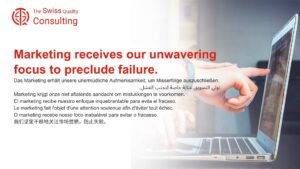How Identifying Your Target Audience Enhances Business Growth
Why Identifying Your Target Audience Is Crucial for Lead Generation
In today’s competitive business landscape, identifying your target audience is essential to effective lead generation and business growth. Without a clear understanding of who your ideal customers are, marketing efforts can become scattershot, leading to wasted resources and minimal results. Knowing your audience allows you to tailor your messaging, refine your marketing strategies, and increase the likelihood of connecting with those who are genuinely interested in your products or services.
For business executives, mid-level managers, and entrepreneurs, especially those operating in the B2B space, defining a target audience means understanding the unique needs, preferences, and pain points of potential clients. In the digital age, where data is more accessible than ever, businesses have the tools to go beyond basic demographic information. Instead of targeting broad segments, businesses can focus on specific industries, job titles, company sizes, and even geographical regions like Switzerland and Swiss cities, where technological and digital transformation trends are particularly relevant.
By honing in on your target audience, you not only improve your messaging but also streamline your lead generation efforts. This results in more qualified leads, better client acquisition, and higher conversion rates. Whether you’re leveraging LinkedIn for professional networking or tapping into digital platforms like AI-powered marketing tools, understanding your audience is the first step toward successful lead generation.
Strategies for Defining Your Target Audience
To successfully implement identifying your target audience, businesses must start with comprehensive research. The process begins by analyzing existing customers, reviewing market trends, and considering industry insights. If you’re in the B2B sector, ask yourself: Who benefits most from my product or service? What industries need my solutions, and what specific roles within those industries make the buying decisions?
Start by analyzing your current customer base. Identify trends in customer behavior, preferences, and challenges. For instance, if your business provides executive coaching services to companies undergoing digital transformation, you’ll likely target upper management or HR professionals in tech-forward industries. Use data from previous sales, client feedback, and even LinkedIn analytics to build a clearer picture of the types of businesses and decision-makers you should be focusing on.
Next, use tools like LinkedIn’s advanced search functions to filter potential leads based on job title, company size, location, and industry. This approach allows you to narrow down prospects that align closely with your product offerings. For example, a Swiss tech company might use LinkedIn to target mid-level managers in Zurich-based financial services firms undergoing digital transformation. Additionally, consider creating buyer personas—fictional representations of your ideal clients—to further refine your audience. A well-constructed buyer persona includes details like job responsibilities, daily challenges, and professional goals, helping you craft messaging that resonates on a personal level.
Using Digital Platforms to Reach Your Target Audience
After identifying your target audience, the next step is to reach them effectively using digital platforms. LinkedIn remains one of the most powerful tools for reaching B2B professionals. With its vast professional network, LinkedIn allows you to connect with decision-makers directly, initiate meaningful conversations, and showcase your expertise through content marketing.
One key strategy is to join and actively participate in LinkedIn groups where your target audience gathers. For example, if your business focuses on artificial intelligence in Switzerland’s finance sector, joining groups centered around digital transformation in financial services can help you engage with potential clients who are already interested in your area of expertise. Regularly posting thought leadership articles, case studies, or insightful comments in these groups can establish your authority and build trust with your audience.
Another digital strategy is leveraging LinkedIn Ads. With LinkedIn’s advanced targeting features, you can direct your ads to specific job titles, industries, and even regions. This makes your ad spend more efficient, ensuring you’re reaching the most relevant audience for your business. Beyond LinkedIn, platforms like Google Ads, Facebook, and even programmatic advertising tools can further help in reaching your defined audience. However, the key to success lies in consistent monitoring and adjusting your campaigns to ensure they are resonating with your audience.
—
Maximizing Business Success by Targeting the Right Audience
Crafting Tailored Messaging for Maximum Engagement
Once you’ve successfully gone through the process of identifying your target audience, it’s critical to create messaging that resonates with them. Each segment of your audience has unique needs, and your content should reflect this. For instance, if you’re targeting CEOs in Switzerland’s technology sector, your messaging should focus on how your product or service can drive innovation and digital transformation—key concerns for leadership in tech industries.
Avoid generic messages that could apply to any audience. Instead, focus on pain points and solutions that directly impact your target audience. Use language that resonates with them, addressing specific challenges they face. For example, for businesses in the metaverse or blockchain space, emphasize the ways your solutions can help them scale securely or improve operational efficiency in a cutting-edge, evolving environment.
Additionally, your messaging should be consistent across all touchpoints—from social media posts and email marketing to website content and digital advertising. Consistent, clear messaging reinforces your brand and makes it easier for potential clients to see the value you offer. It also builds trust, which is essential for converting leads into loyal customers.
Measuring and Refining Your Audience Targeting Efforts
The process of identifying your target audience doesn’t end after your initial research and outreach. It’s important to continually measure the effectiveness of your campaigns and refine your strategies as needed. Use analytics tools like Google Analytics, LinkedIn Insights, and CRM platforms to track how well your marketing efforts are reaching and engaging your target audience.
Key performance indicators (KPIs) such as engagement rates, conversion rates, and lead quality should be closely monitored. For example, if your LinkedIn Ads are receiving clicks but not converting into leads, it may indicate a need to refine your messaging or adjust your targeting parameters. Regular analysis of these metrics helps ensure that your campaigns remain aligned with your audience’s evolving needs and behaviors.
By staying adaptable and responsive to feedback, you can continually refine your understanding of your target audience. This iterative process ensures that your marketing strategies remain effective, your audience remains engaged, and your business continues to grow in a competitive marketplace.
—
Conclusion: The Power of Identifying Your Target Audience for Lead Generation
Successfully identifying your target audience is the foundation of effective lead generation and business growth. By thoroughly understanding who your ideal clients are, what their challenges and needs are, and how they prefer to be reached, you can tailor your marketing strategies to resonate with them on a deeper level. Whether through LinkedIn networking, digital advertising, or content marketing, defining and reaching the right audience will drive more qualified leads, increase conversion rates, and ultimately, help your business thrive.
Remember, the process doesn’t stop at the initial research. Continually refine your audience and marketing efforts to keep up with changing industry trends and customer needs. By doing so, you’ll ensure long-term success and a strong, sustainable connection with your audience.
—
#LeadGeneration #BusinessLeads #SalesLeads #Marketing #B2B #Networking #ClientAcquisition #Entrepreneurship #SmallBusiness #GrowthHacking













